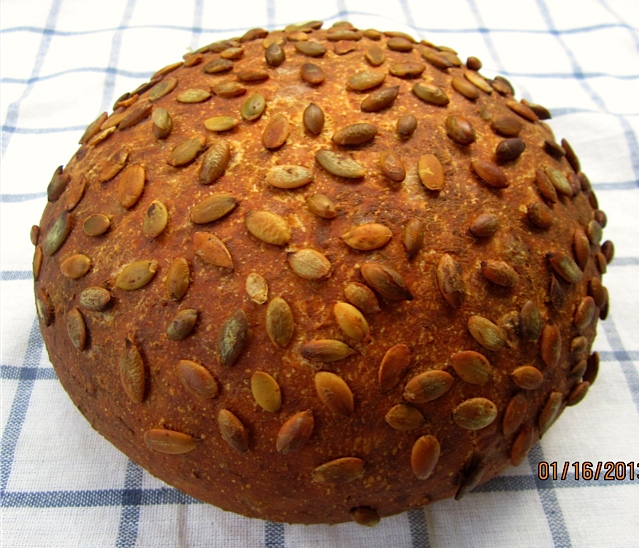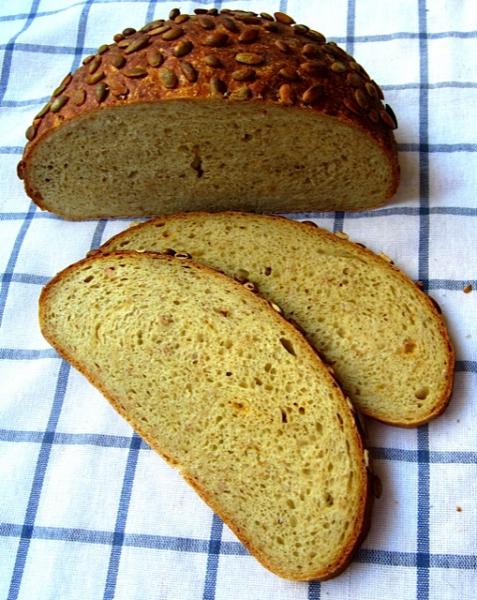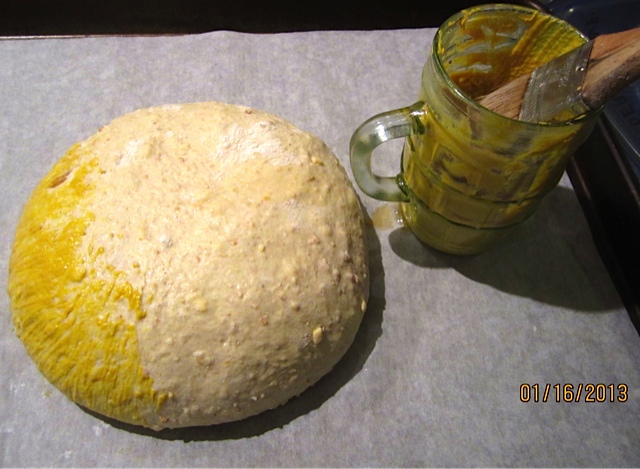
10/7/18 This post has been updated to include a sourdough starter here
Facebook friend and co-baker David Wolfe asked me to help him understand some terms in a German recipe. Google translate (always good for a laugh!) is not too fluent in professional German baking lingo.
The formula, published by a German bakers' association, Bäko Gruppe Nord, seemed quite intriguing, combining rye meal and cracked wheat with mustard and cheese. The amounts, of course, were calculated for a commercial bakery (19 kg/43 lb), as were the instructions.
My curiosity was wakened, especially after I saw David's appetizing photos in his blog "Hearth Baked Tunes" so I downsized the formula for two small loaves.
The original recipe requires 16% of the white flour as preferment, all the remaining flour, including the coarse grinds, is worked into the final dough. The breads are baked "bei Brötchentemperatur" ("at roll temperature") - leaving hapless hobby bakers clueless as to what that might be.
But I don't donate for nothing to Wikipedia, a quick research at the German site showed me the light: the breads were to be baked at 465ºF/240ºC.
Since I'm a friend of long fermentation (also from a physician's point of view,) I re-wrote the procedure from using just a small amount of preferment, to preferment plus soaker for the coarse ground rye and wheat, as well as an overnight bulk fermentation.
I can honestly say I never noticed a difference between adding the salt with all the other ingredients, or adding it later to the almost finished dough, as the recipe stated. Peter Reinhart (my guru) mixes everything together at the same time, and I do, too.
For the cheese you can choose between Gouda or Tilsiter. I don't care for stinky cheeses, so I went for the Dutch. Though the recipe didn't specify what kind, I was sure that middle aged cheese (18-month) would work better, as I use it for gratins. Young Gouda is too mild, and really old Gouda unnecessary expensive.
I was very pleased with the result, a beautiful red golden bread, covered with seeds, with a pleasant spiciness, but not too much. It tasted great with cold cuts, and was a wonderful surprise when toasted: a bread with in-built grilled cheese!

The crumb has a nice yellow color from the mustard
SENFBROT - MUSTARD BREAD (2 small loaves)
Preferment
140 g/5 oz bread flour
84 g/3 oz water
1 g/ 1/4 tsp. instant yeast
2 g/0.12 oz salt
Soaker
104 g/3.7 oz wheat meal, coarse
70 g/2.5 oz rye meal
130 g/4.4 oz water
3 g/0.12 oz salt
Final Dough
all preferment
all soaker
556 g/19.6 oz bread flour
15 g/0.5 oz instant yeast
16 g/0.6 oz salt
408 g/14.3 oz water
66 g/2.3 oz mustard
122 g/4.3 oz middle aged Gouda (18 month old), coarsely grated or cut in chunks
mustard for brushing
sunflower or pumpkin seed for topping (I used pumpkin seed)

After shaping the loaves are brushed with mustard - I used a medium-hot one from Düsseldorf
DAY 1:
In the morning, mix preferment and soaker. Leave at room temperature until using.
In the evening, mix all final dough ingredients at low speed (or by hand) for 1 - 2 minutes, until all flour is hydrated. Let rest for 5 minutes, then knead at medium-low speed (or by hand) for 6 minutes, adjusting with a little more water or flour, if necessary (but beware: dough should be somewhat sticky, clearing only sides of bowl, but stick to bottom!)
Transfer dough to a lightly oiled work surface. With oiled hands, stretch and pat it into a square, first fold top and bottom in thirds, like a business letter, then do the same from both sides.
Gather dough into a ball, place seam side down into a lightly oiled bowl, cover, and let it rest for 10 minutes.
Repeat S & F 3 times, at 10 minute intervals. After last fold, place dough in lightly oiled container with lid and refrigerate overnight. (I divide the dough at this point already in halves, and refrigerate them in two containers.)
DAY 2:
Remove dough from fridge 2 hours before using.
Preheat oven to 465ºF/240ºC, including baking stone and steam pan. Place seeds for topping on a plate.
Shape dough into 2 boules, brush them with mustard, and then roll them in sunflower or pumpkin seeds.
Place breads, seam side down, on parchment lined baking sheet, and proof, until they have grown 1 1/2 times their original size.
Bake for 15 minutes, steaming with 1 cup of boiling water. Remove steam pan, and rotate breads 180 degrees.
Reduce temperature to 210ºC/410ºF, and continue baking for another 25 minutes, or until breads are a deep reddish brown, sound hollow when thumped at the bottom, and register at least 200ºF/93ºC.
Let breads cool on a wire rack.
After brushing the loaves with mustard, they are rolled in pumpkin seeds.

Submitted to YeastSpotting
- hanseata's Blog
- Log in or register to post comments
Colorful! What kind of mustard did you use?
A German mustard we bought at the Commissary, medium-hot. In the recipe it's just "Senf", so an average mustard will do. I wanted just a hint of spice, not a pungent taste.
Karin
I have to note that another member, in the one chance possible where no one would question it, didn't stick some black mustard seeds to the mustard - if only just to fill the gaps between those huge, hoggish other seeds that have nithing to do with mustard:-)
You know that my apprentice will be making this bread with her home made Dijon brats and proper seedifications.
Yours looks very enticing and a great pastrami would go well with it too. I'm very hungry fo some reason.
Nice baking Hanseata.
Will certainly be fine, and I have to admit, I was sorely tempted to add some hemp (just to please you and your apprentice), but, alas, I was too timid. Perhaps I should have had some home made Dijon brats to give me the necessary courage...
Karin
Wow..what a fantastic combination and beautiful looking bread. So how much do you actually taste the mustard in the bread?
Great bake Hanseata.
Regards,
Ian
Thanks, Ian. The bread has just a nice hint of spiciness, but you wouldn't necessarily know that it is mustard. A really unusual ingredient, I would have never dreamed of using it in bread.
Karin
Hi Karin,
A new ingredient to try in a new recipe :-) I have never even thought of adding mustard 'in' a dough as an ingredient! Sounds like it was really tasty so I will have to give it a whirl and see what my 'tasters' think of the combination.
Now to find a mustard that will do the trick without adding too much of a kick though from reading David's blog it sounds as though strong is the way to go.....Will check out what Whole Foods has to offer when I do my weekly shopping on Tuesday....
Thanks for the inspiration and new flavor combo!
Take Care,
Janet
I like mustard, but not in large amounts. I'm sure the original recipe would have listed "Senf, extra scharf" (= extra hot mustard), if they meant a really strong mustard taste "with a kick".
Let me know what you think of it!
Take care,
Karin
Hi Karin,
At the store today only mustard I found was a can of dry Coleman's mustard....Nobody here eats mustard so none in the house. I am thinking that the Coleman's is bland to say the least....this is Colorado and our reputation comes from skiing...not culinary delicacies :-) I imagine if I could find a speciality store I could come up with something closer to what you used but do you think the Coleman's will work? (Not sure if you have ever had it but I remember my dad eating it when I was young. I couldn't stand the stuff..... :-O
Janet
Thanks for this suggestion and the one below. I would mix with water first to make a liquid as suggested on the can and that is how I recall my father doing it. Offers a good way to tone it down too along with your suggestion for honey and egg yolk.
Take Care,
Janet
You always learn something new! But since mustard is an important ingredient here, it should not be a bad tasting one. We fortunately can get some award winning local Maine mustard here, produced by a real mustard manufactory with a mill: Raye's.
Karin
YUM! mustard and cheese, and with pumpkin seeds on top.. what a treat this bread must have been.
Karin, excellent bread with a beautiful looking crumb. Lovely.
khalid
A praise from an excellent baker like you is always welcome.
I hope you are feeling well again!
Karin
what a beautiful bread. inspiring... yum
evon
Thank you, Evon, I hope it will tempt others to try it, too.
Happy Baking,
Karin
Just to confirm: the mustard in the dough is a prepared mustard, not mustard powder, right?
The aged gouda sounds lovely, which makes me think that there might be a range of assertive cheeses that would also be good, if less authentic.
Paul
I don't think you have to worry about authenticity, Paul. This is not a traditional bread, but a modern bread specialty to give bread loving customers more choices.
I was very pleased with the taste of the middle aged Gouda. I had baked breads with Brie, Camembert and Feta before, and was never convinced by the result. The Camembert yielded "musty" bits, the Brie was indiscernible, and the Feta unpleasantly pungent.
Choose the cheese you like, and that tastes good toasted, too, then you can't go wrong.
Karin
either. I was thinking more of Havarti, or Emmentaler, or possibly a Cheddar-style, suitably aged. Growing up in Michigan, there was always Pinconning or Frankenmuth cheese available. No doubt a Gruyere would be lovely, too, but it seems a waste to pay that much for a cheese and then bake it into a bread. I'm no fan of blue or green cheeses, but have noticed that blue cheese mellows tremendously when baked in bread.
So many possibilities!
Paul
would certainly work, Paul. And it is really mustard, not seeds or powder. Do try it, and let me know what you think.
Karin
Hi Karin,
That is a lovely looking loaf of bread.
I wanted to add to Mini's note above, that Mustard Powder, let down to a wet paste with water is also an option. I have used it to laminate savoury biscuits with success.
Great flavours in this, I'm sure
All good wishes
Andy
pinch of salt. Watch carefully and lower temp or cover to prevent honey & yolk from burning. I'd experiment with the taste first. I think there is a mustard post or two in the site archives.
One of my favorite chicken bakes is a whole chicken smeared inside and out with a few tablespoons of prepared mustard with a little splash soy sauce inside. Thinning the dry mustard with water and soy sauce is another idea. Fresh thyme seems to want to join the party. Taste the combination first to balance it.
Chicken and dumplings... wondering... a little bit of mustard in sourdough/rye dumplings would also be interesting. Or mustard bread croutons in pumpkin soup... or buttered toasted mustard bread with squash souffle... wait... first lining the bowl with buttered mustard bread, ultra thin slices or coarse pulsed crumbs and then the souffle... baked to a gorgeous golden brown with a wonderful green salad. Ah yes! I can almost smell it. :)
Mini
Mini, you are, as usual, a fountain of wisdom!
I use mustard as seasoning in meat balls and my grandmother's meat loaf.
Happy Baking,
Karin
Thanks, Andy, I do appreciate your friendly comment.
And that is an interesting information - I made Lepard's Stilton crust for savory pastry, sprinkling the puff pastry with grated Stilton, but I can imagine a mustard layering must create another nice flavor option.
Happy Baking!
Karin